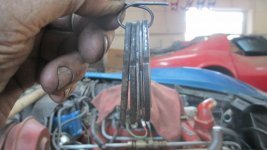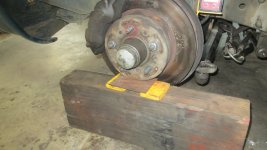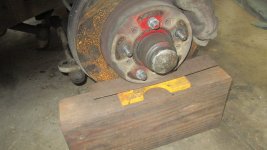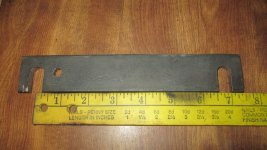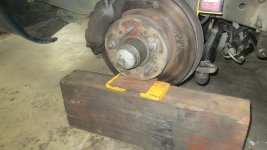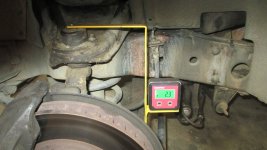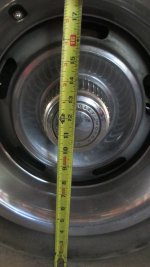Navigation
Install the app
How to install the app on iOS
Follow along with the video below to see how to install our site as a web app on your home screen.
Note: This feature may not be available in some browsers.
More options
Style variation
You are using an out of date browser. It may not display this or other websites correctly.
You should upgrade or use an alternative browser.
You should upgrade or use an alternative browser.
Doing Your Own Front End Alignment
- Thread starter toobroketoretire
- Start date
- Status
- Not open for further replies.
dougelam
Well-known member
I seem to be the only person who has thought of this and that puzzles me.
THINK ABOUT THAT!!!
Sent from my SM-T530NU using Tapatalk
- Thread starter
- #63
toobroketoretire
Banned
Aligning Your Own Front End
People have always assumed it takes highly-specialized equipment to do a front end alignment but that's a false assumption. All you need is a simple home made tool, an angle finder, a 11/16" wrench, a tape measure, and a little patience. Plus you can brag to your buddies and say "I can do my own front end alignments". Sometimes things seem real hard until you delve into them and discover they're not so hard after all. And why shell out $100+ for a front end alignment when you can do it yourself and learn something at the same time? We only live once so we might as well learn as much as we can in our short lifespan.
People have always assumed it takes highly-specialized equipment to do a front end alignment but that's a false assumption. All you need is a simple home made tool, an angle finder, a 11/16" wrench, a tape measure, and a little patience. Plus you can brag to your buddies and say "I can do my own front end alignments". Sometimes things seem real hard until you delve into them and discover they're not so hard after all. And why shell out $100+ for a front end alignment when you can do it yourself and learn something at the same time? We only live once so we might as well learn as much as we can in our short lifespan.
LLC5
Well-known member
And why shell out $100+ for a front end alignment when you can do it yourself and learn something at the same time?
There are so many holes to your procedures that I don't even know where to start. But to answer your question, the reason to pay good money to a knowledgeable and competent business with the proper equipment is to make sure that the alignment gets done correctly and that your vehicle is safe to drive. Money in the bank. Your procedure is throwing away good money in home repair tools (unless you will eventually use them for a home repair) to eventually lead into spending money on a quality alignment anyway. The only thing to learn from your procedure would be to never do it twice.
dougelam
Well-known member
You knowww,There are so many holes to your procedures that I don't even know where to start. But to answer your question, the reason to pay good money to a knowledgeable and competent business with the proper equipment is to make sure that the alignment gets done correctly and that your vehicle is safe to drive. Money in the bank. Your procedure is throwing away good money in home repair tools (unless you will eventually use them for a home repair) to eventually lead into spending money on a quality alignment anyway. The only thing to learn from your procedure would be to never do it twice.
I would be willing to bet that someone that worked on their OWN car all the time at home in their garage and not having access to a full service garage equipment could conceivably use his method and ONLY after trial and error on that one vehicle find alignment settings that didn't wear out tires as quickly then not adjusting it at all!
I can't believe I'm saying this out loud
Sent from my SM-N920P using Tapatalk
kpic
Well-known member
- Joined
- Mar 29, 2014
- Messages
- 2,292
- Location
- Columbus, NC/NE Georgia
- Corvette
- 1997 boosted silver coupe
As toobroke.... does his own alignments and under inflates his tires his tire life must be abysmal.
I am so grateful he is many miles from me..
I am so grateful he is many miles from me..
- Thread starter
- #67
toobroketoretire
Banned
Aligning Your Own Front End
So what exactly is the "caster" angle of a vehicle? Well, it's the rearward tilt of the front spindle that makes the vehicle track straight ahead when you let go of the steering wheel. For those of you who don't fully understand what a caster angle is I suggest Googling "Caster Angle" and read what Wikipedia has to say about it. The faster a vehicle goes the more it needs an increased caster angle but the steeper the caster angle is the more effort it takes to steer that vehicle at low speeds. The C3's specs call for a 2-1/4 plus/minus 1/2 degree for average usage so anything between 1-3/4 to 2-3/4 degrees is okay.
If you have a vehicle that doesn't have upper and lower ball joints look it over and see what kind of a tool you can fabricate that will allow you to measure the caster angle. But remember this................the front end of the vehicle must be sitting at it's usual height when you measure the caster angle. You can measure the caster angle with your vehicle sitting on a slanted surface but you must take into account how many degrees the surface is slanted. If the slant is say 1-1/2 degrees then you would add that 1-1/2 degrees to your caster angle. In other words if the surface is slanted 1-1/2 degrees and you want a 2-1/4 degree caster angle you would set the caster angle to 3-3/4 degrees (1-1/2 for the surface PLUS 2-1/4 for the caster angle).
So with a simple home made tool and an angle finder you can align your own front end at home and save a bunch of money while learning something new. A WIN WIN situation!
So what exactly is the "caster" angle of a vehicle? Well, it's the rearward tilt of the front spindle that makes the vehicle track straight ahead when you let go of the steering wheel. For those of you who don't fully understand what a caster angle is I suggest Googling "Caster Angle" and read what Wikipedia has to say about it. The faster a vehicle goes the more it needs an increased caster angle but the steeper the caster angle is the more effort it takes to steer that vehicle at low speeds. The C3's specs call for a 2-1/4 plus/minus 1/2 degree for average usage so anything between 1-3/4 to 2-3/4 degrees is okay.
If you have a vehicle that doesn't have upper and lower ball joints look it over and see what kind of a tool you can fabricate that will allow you to measure the caster angle. But remember this................the front end of the vehicle must be sitting at it's usual height when you measure the caster angle. You can measure the caster angle with your vehicle sitting on a slanted surface but you must take into account how many degrees the surface is slanted. If the slant is say 1-1/2 degrees then you would add that 1-1/2 degrees to your caster angle. In other words if the surface is slanted 1-1/2 degrees and you want a 2-1/4 degree caster angle you would set the caster angle to 3-3/4 degrees (1-1/2 for the surface PLUS 2-1/4 for the caster angle).
So with a simple home made tool and an angle finder you can align your own front end at home and save a bunch of money while learning something new. A WIN WIN situation!
LLC5
Well-known member
So with a simple home made tool and an angle finder you can align your own front end at home and save a bunch of money while learning something new. A WIN WIN situation!
And the hits keep on coming.
Yes, you certainly can align your vehicle at home even with no tools or working practical knowledge of what you are doing, free of charge no less. But unless you just plain got lucky and believe in the tooth fairy, it will be incorrect. A LOSE LOSE situation!
Antz81
Well-known member
Toobroke I'm curious, have you ever had you method of alignment verified for being accurate after you have done your self alignment?
- Thread starter
- #70
toobroketoretire
Banned
Aligning Your Own Front End
I am getting real close to finishing my upper and lower control arm bushing installation so tomorrow morning I'll be doing a front end alignment on my '71. With my simple home made tool and magnetic base angle finder it'll be an easy job. When starting from scratch I start with one 1/8" shim in the front and three 1/8" shims in the rear then go from there. The amount of shims needed in the left and right sides will rarely be equal because of manufacturing tolerances combined with minor frame tweaking over the years.
I am getting real close to finishing my upper and lower control arm bushing installation so tomorrow morning I'll be doing a front end alignment on my '71. With my simple home made tool and magnetic base angle finder it'll be an easy job. When starting from scratch I start with one 1/8" shim in the front and three 1/8" shims in the rear then go from there. The amount of shims needed in the left and right sides will rarely be equal because of manufacturing tolerances combined with minor frame tweaking over the years.
kpic
Well-known member
- Joined
- Mar 29, 2014
- Messages
- 2,292
- Location
- Columbus, NC/NE Georgia
- Corvette
- 1997 boosted silver coupe
Once upon a time....
dougelam
Well-known member
This is a story of toobrokes hometown
Hilarious DIY car repair bodge jobs carried out by amateur mechanics | Daily Mail Online
Sent from my SM-N920P using Tapatalk
Hilarious DIY car repair bodge jobs carried out by amateur mechanics | Daily Mail Online
Sent from my SM-N920P using Tapatalk
Peer81
Well-known member
I would also like to know if your measurements (or those from a shop) are far off each other.
And you start with those shims but from there first caster or toe, camber? It would be nice to see if the wheelsettings change over time
Greetings Peter
Verstuurd vanaf mijn GT-I9195 met Tapatalk
And you start with those shims but from there first caster or toe, camber? It would be nice to see if the wheelsettings change over time
Greetings Peter
Verstuurd vanaf mijn GT-I9195 met Tapatalk
- Thread starter
- #74
toobroketoretire
Banned
Aligning Your Own Front End
I just got my new polyurethane upper and lower control arm bushings installed then dove into the front end alignment. As my normal grease cap height is 11-5/8" above the ground I blocked and shimmed both sides to equal that dimension with the wheels/tires off to ensure an accurate measurement of the caster and camber angles. I set both sides to a 2-1/2 degree caster and a .3 degree positive camber and I'll re-check those settings after I put a few thousand miles on the new bushings. After I put the wheels/tires back on I'll set the toe-in to about 3/16" by adjusting the tie rod lengths.
Here's a hint regarding the shim packs. To prevent the shims pack from falling apart (and shims dropping under the car) wire them together as you add/remove shims and always put the thinner shims between the thicker 1/8" shims. And as I stated before always tighten the nut on the thinnest shim pack first THEN the thicker shim pack. That ensures the thinner shim pack gets squeezed hard enough to prevent it from falling out.
I just got my new polyurethane upper and lower control arm bushings installed then dove into the front end alignment. As my normal grease cap height is 11-5/8" above the ground I blocked and shimmed both sides to equal that dimension with the wheels/tires off to ensure an accurate measurement of the caster and camber angles. I set both sides to a 2-1/2 degree caster and a .3 degree positive camber and I'll re-check those settings after I put a few thousand miles on the new bushings. After I put the wheels/tires back on I'll set the toe-in to about 3/16" by adjusting the tie rod lengths.
Here's a hint regarding the shim packs. To prevent the shims pack from falling apart (and shims dropping under the car) wire them together as you add/remove shims and always put the thinner shims between the thicker 1/8" shims. And as I stated before always tighten the nut on the thinnest shim pack first THEN the thicker shim pack. That ensures the thinner shim pack gets squeezed hard enough to prevent it from falling out.
Attachments
- Thread starter
- #75
toobroketoretire
Banned
Aligning Your Own Front End
About 8 to 9 months ago (and in another C3 forum) I told the members how I have been aligning my own front ends since I was an 18 year old kid by using a simple home made tool and an angle finder..............with my wheels/tires off! When the members read I did my alignments with my wheels/tires off several of the members told me I was an idiot and a stupid fool because anyone with brains KNOWS that can't be done. Oh really? Hmm. Since I have been aligning my own front ends for 50 years and my vehicles performed perfectly I guess I was doing something right, huh? The point is the very important caster and camber angles can easily be set with the wheels/tires OFF and then they are put back on for the toe in adjustment (after the vehicle has been rolled back and forth a few times to "normalize" the front end. The C3 specs for the toe in are rather generous as anything from 1/8" to 1/4" will do. As the vehicle rolls down the highway and plows thru the air the tires are pushed slightly backwards so that's why they need a bit of toe in.
You can buy shim kits from all the C3 vendors that have the common 1/8", 1/16", and 1/32' shims for about $25 but You can also make one-piece shims of any thickness that spans the distance from the front to the rear. Here's a picture of one of my 1/4" thick one-piece shims I made many years ago for a '68 Camaro I had. I also have one-piece 1/8" shims and 1/16" shims. The idea being to use a thick one-piece shim for the front and rear so you can save your other individual shims for "fine tuning" the thickness of the shim pack.
About 8 to 9 months ago (and in another C3 forum) I told the members how I have been aligning my own front ends since I was an 18 year old kid by using a simple home made tool and an angle finder..............with my wheels/tires off! When the members read I did my alignments with my wheels/tires off several of the members told me I was an idiot and a stupid fool because anyone with brains KNOWS that can't be done. Oh really? Hmm. Since I have been aligning my own front ends for 50 years and my vehicles performed perfectly I guess I was doing something right, huh? The point is the very important caster and camber angles can easily be set with the wheels/tires OFF and then they are put back on for the toe in adjustment (after the vehicle has been rolled back and forth a few times to "normalize" the front end. The C3 specs for the toe in are rather generous as anything from 1/8" to 1/4" will do. As the vehicle rolls down the highway and plows thru the air the tires are pushed slightly backwards so that's why they need a bit of toe in.
You can buy shim kits from all the C3 vendors that have the common 1/8", 1/16", and 1/32' shims for about $25 but You can also make one-piece shims of any thickness that spans the distance from the front to the rear. Here's a picture of one of my 1/4" thick one-piece shims I made many years ago for a '68 Camaro I had. I also have one-piece 1/8" shims and 1/16" shims. The idea being to use a thick one-piece shim for the front and rear so you can save your other individual shims for "fine tuning" the thickness of the shim pack.
Attachments
Antz81
Well-known member
About 8 to 9 months ago (and in another C3 forum) I told the members how I have been aligning my own front ends since I was an 18 year old kid by using a simple home made tool and an angle finder..............with my wheels/tires off! When the members read I did my alignments with my wheels/tires off several of the members told me I was an idiot and a stupid fool because anyone with brains KNOWS that can't be done. Oh really? Hmm. Since I have been aligning my own front ends for 50 years and my vehicles performed perfectly I guess I was doing something right, huh?
Did they say it can't be done or shouldn't be done, or couldn't be done the way you have said? I think all of us here agree with them anyway.
You say your alignment is perfect, but given there are flaws in your method, and from what I can tell your car has never been into a shop to have it checked; I'm gonna say it might be close to OK, it will not be perfect.
- Thread starter
- #77
toobroketoretire
Banned
Aligning Your Own Front End
When you hang the tool onto the grease zerks you'll immediately notice it can swing from side-to-side and that'll show a change of several tenths of a degree in the caster angle. To prevent it from swinging just place a heavy piece of steel onto the lower control arm AND the tool and that'll stabilize it. You want the tool to be PARALLEL to the rotor's surface to measure the caster angle (sorry, no picture). With the tool in place (and stabilized) the angle finder will display your caster angle. The digital angle finder will measure the angle to 1/10th of a degree so it's plenty accurate.
Things aren't always as hard as they seem as anyone can align their own front ends.
When you hang the tool onto the grease zerks you'll immediately notice it can swing from side-to-side and that'll show a change of several tenths of a degree in the caster angle. To prevent it from swinging just place a heavy piece of steel onto the lower control arm AND the tool and that'll stabilize it. You want the tool to be PARALLEL to the rotor's surface to measure the caster angle (sorry, no picture). With the tool in place (and stabilized) the angle finder will display your caster angle. The digital angle finder will measure the angle to 1/10th of a degree so it's plenty accurate.
Things aren't always as hard as they seem as anyone can align their own front ends.
LLC5
Well-known member
Since I have been aligning my own front ends for 50 years and my vehicles performed perfectly I guess I was doing something right, huh?
No, it only means that you have been doing your own alignments for 50 years.
It does not mean that they have been done right.
Peer81
Well-known member
So if i underatand you correctly you hang the tool onto the grease zerks but how? I understand on that side you don't have problems with with rotor runout or bearing wear altho you want the bearing wear tobe included as it affects tire wear.
And from my perspective the more distance is between the upper and lower measurement points the more accurate the measurement will be. That way i placed my garage windowframe perfectly vertical with a short level. It was perfect till a toolman gave me a long level... I had to redo most of them.
On the other hand with the front suspension being not that perfect (crap camber travel) why should i get my alignment perfect?
Greetings Peter
Verstuurd vanaf mijn GT-I9195 met Tapatalk
And from my perspective the more distance is between the upper and lower measurement points the more accurate the measurement will be. That way i placed my garage windowframe perfectly vertical with a short level. It was perfect till a toolman gave me a long level... I had to redo most of them.
On the other hand with the front suspension being not that perfect (crap camber travel) why should i get my alignment perfect?
Greetings Peter
Verstuurd vanaf mijn GT-I9195 met Tapatalk
- Thread starter
- #80
toobroketoretire
Banned
Aligning Your Own Front End
I set my toe in to 1/8" this morning (it was 7/16") so now I'll drive it several thousand miles and check the alignment again after the new polyurethane bushings have had a chance to "settle". As it's so easy to check the alignment using my simple tool and an angle finder you can check yours any time you have your front wheels/tires off by setting the rotor onto a block of wood and shimming to the same height as it normally is. As the control arm bushings collapse over time the caster angle will increase and the camber angle will decrease so with the tool, an angle finder, and a set of shims you can periodically adjust it to keep it uh "tuned). Isn't knowledge great?
I set my toe in to 1/8" this morning (it was 7/16") so now I'll drive it several thousand miles and check the alignment again after the new polyurethane bushings have had a chance to "settle". As it's so easy to check the alignment using my simple tool and an angle finder you can check yours any time you have your front wheels/tires off by setting the rotor onto a block of wood and shimming to the same height as it normally is. As the control arm bushings collapse over time the caster angle will increase and the camber angle will decrease so with the tool, an angle finder, and a set of shims you can periodically adjust it to keep it uh "tuned). Isn't knowledge great?
Attachments
- Status
- Not open for further replies.
Similar threads
- Replies
- 0
- Views
- 3K
- Replies
- 0
- Views
- 1K
- Replies
- 0
- Views
- 123
- Replies
- 0
- Views
- 2K

